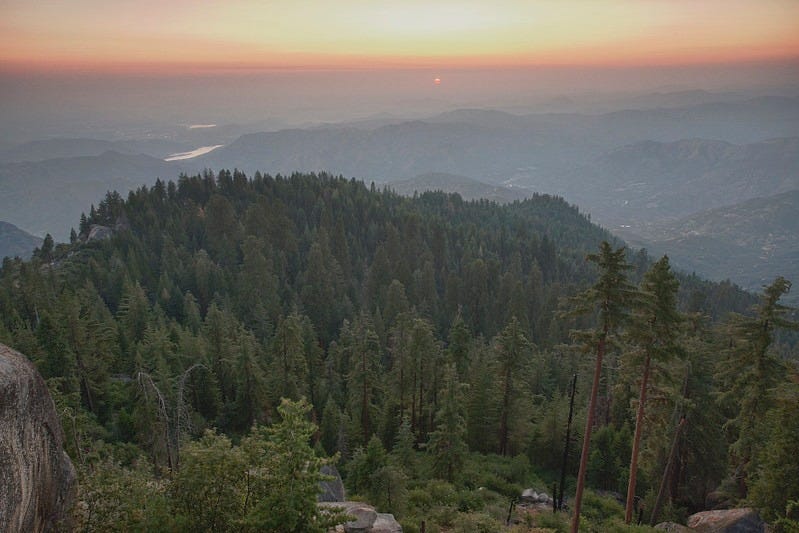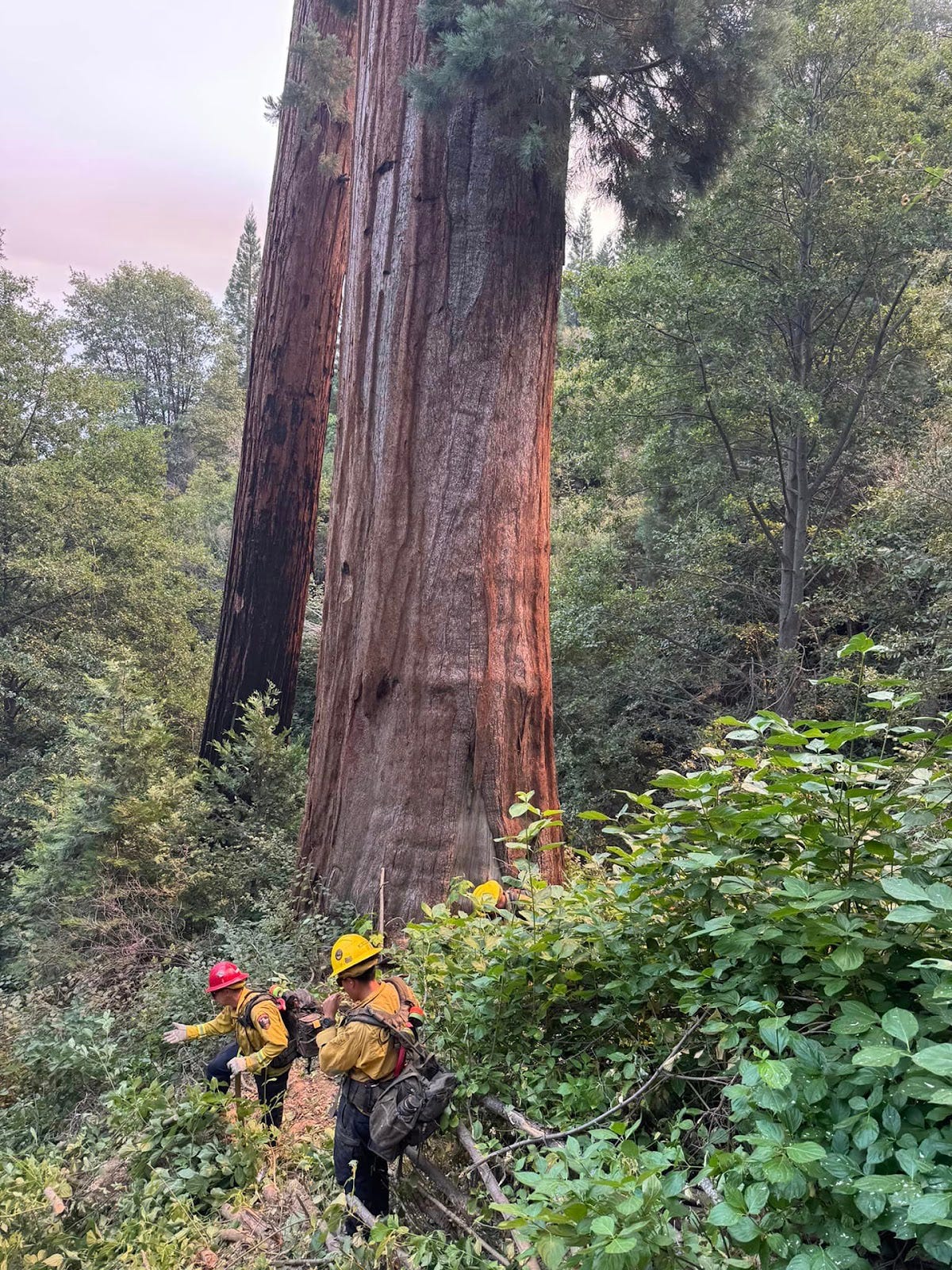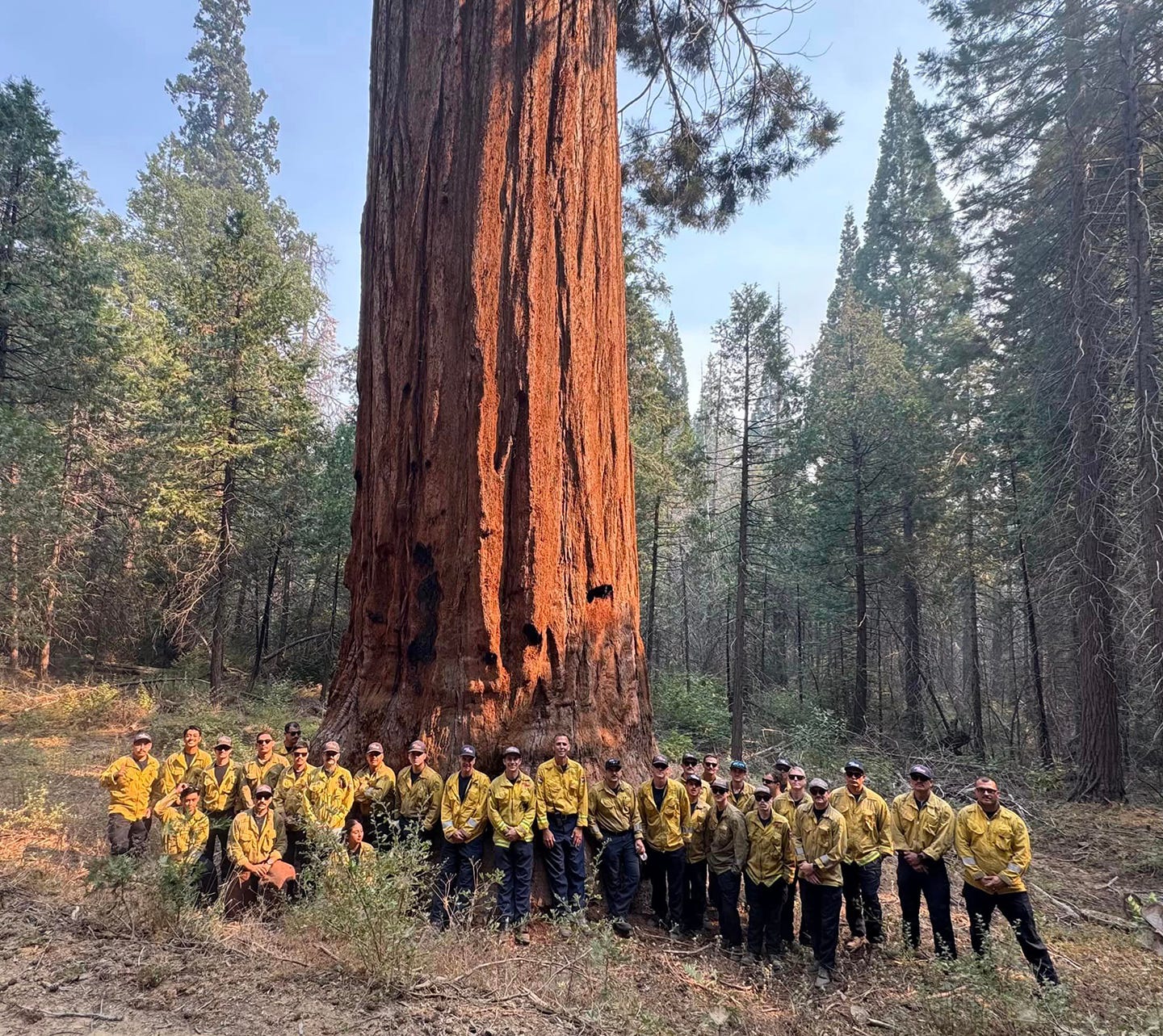Volume 3, Number 5 - Thursday, Aug. 22, 2024
Published every Monday and Thursday

Perspective
THE LOSS OF SO MANY GIANT SEQUOIAS in wildfires from 2015 to 2021* (HERE) did not mean that no efforts were made to save the trees during those fires.
You may recall that during the 2021 KNP Complex Fire, the National Park Service wrapped the base of the venerable General Sherman Tree in burn-resistant foil, as the Fresno Bee reported HERE.
Since then, land managers up and down the Sierra Nevada have engaged in many efforts to protect remaining trees, as the Giant Sequoia Lands Coalition reported in its 2023 Annual Report HERE.
Efforts continue as the Coffee Pot Fire burns in or near several giant sequoia groves.
Yesterday, the Bureau of Land Management’s Bakersfield office announced the temporary closure of its Case Mountain Extensive Recreation Management Area in Tulare County due to wildland fire danger from the fire. You can read the BLM’s news release HERE.
As noted in the release, the Case Mountain recreation area “is approximately 20,000 acres of BLM-managed public land (and) contains the only Sequoia grove complex managed by the Bureau of Land Management.
“The complex is comprised of six distinct sequoia grove units, which total about 444 acres. The area is also part of the Milk Ranch Peak Wilderness Study Area and the nearly 20,000-acre Kaweah Area of Critical Environmental Concern, which is designated for protection of the Case Mountain giant sequoia groves, other sensitive plant and animal species, riparian areas, and cultural resources.”
Yesterday, Cal Fire’s Tulare Unit reported on Facebook that its Strike Team 9419G was hard at work on the Coffee Pot Fire: “Today our crews have been working with Park Service and Bureau of Land Management staff to identify sequoia trees and create hand line around each tree as well as limb up branches that could be fuel for fire. This work is in an effort to make the trees more defensible.”
Of course, firefighters are concerned about people and other resources, too. Evacuation warnings were issued on Tuesday for some areas and parts of Sequoia National Forest are also closed to the public.
As I reported Monday, this is a full-suppression fire burning on lands managed by Sequoia and Kings Canyon National Parks and the Bureau of Land Management. It was started by lightning on Monday, Aug. 3. Officials are prioritizing firefighter safety, life, property and then natural resources (including giant sequoias).
On Sunday, the fire reportedly entered Surprise Grove and burned but did not do any damage.
As of the latest report this morning, the fire was at 2,231 acres with no containment. A total of 615 personnel were assigned to the fire.
Here’s the report on InciWeb:
The Coffee Pot Fire continues to gradually spread and advance in all directions. During the last few days, low to moderate fire behavior has allowed fire crews and bulldozers to make significant progress in constructing indirect control lines along the west and south flanks. Water-dropping planes and helicopters have supported these efforts by reducing the fire's intensity, particularly on the western flank. Fire activity is expected to slow leading into the weekend as temperatures cool and humidity increases. Any new fire growth will likely be limited to areas with easily combustible vegetation such as dead branches, leaves, and needles.
Today, firefighters will continue working along Salt Creek Road clearing brush to strengthen the indirect control lines on the west and south flank. Additionally, crews will focus on protecting the giant sequoia groves adjacent to Case Mountain by removing vegetation to reduce fire intensity. Six hotshot crews are working alongside other crews to secure ridges and roads that have been identified as control features. In the coming days, firefighters will concentrate on clearing vegetation along Cinnamon Gap and Mineral King Roads.
Cooler weather is expected to aid firefighters through the weekend and poor air quality will continue to be an issue. Information about the fire is on Inciweb HERE.


Giant sequoia controversy
Earlier this month, NBC News produced a short but informative piece addressing the giant sequoia controversy I regularly cover in this newsletter. It’s worth a watch, HERE.
Non-native giant sequoias
This newsletter used to include a weekly feature, “Giant Sequoias around the world,” and I may resume this in the future. In the meantime, I always appreciate receiving photos of these great trees growing elsewhere. Reader Jeff Gletne shared these two photos from his recent visit to Fort Defiance Park in Tacoma, Washington.
Another reader, Jim Hamerly, has started a new Facebook page called “Sequoia Growers From All Over the World.” You can find it HERE. Hamerly, you may recall, has planted many giant sequoia groves on Mount Palomar in San Diego County. (More info HERE). He’s been tracking down giant sequoias all over the world and notes:
“We have ~400+ sequoias on Palomar Mountain, and we have located sequoias and growers in 46 of the 50 states and the District of Columbia in the US, in 20 European countries, as well as the Southern Hemisphere and Japan. The UK is reported to have over 500,000 trees!”
Wildfire, water & weather update
Weird weather update — According to the National Weather Service, it hasn’t snowed in the high Sierra in August for at least 20 years, but a dusting of snow is possible in Yosemite this weekend as remnants of a typhoon bring cooler weather to California. You can read about the impact of Typhoon Ampil HERE (SF Chronicle gift link) and see the NWS forecast below.
You’ve probably heard that California had its hottest July on record last month (as did New Hampshire), and 19 additional states had their top 10 warmest July on record. There’s more information about July from climate.gov HERE.
The chart HERE from National Predictive Services, California Ops South shows that cooler weather in coming days is good news for firefighters.
Sequoia National Forest issued its final update about the Borel and SQF Lightning Fires on Monday afternoon. At the time, the Borel fire was at 59,288 acres with 94% containment, the Trout fire was at 23,822 acres with 75% containment, and the Long Fire was at 9,204 acres with 98% containment. California Interagency Incident Management Team 2 was to transition command of the Borel Fire to a local type-3 organization, and the Trout Fire was to be transitioned to a type-4 organization.
The latest California Drought Map (HERE) shows a bit of severe drought near the Siskiyou County border with Oregon, moderate drought in much of that county and Modoc, and abnormally dry conditions in much of Northern California and the far southeastern part of the state. Nearly all of Oregon is in even worse shape (HERE).
The best Sierra Nevada weather forecasts are at NWS Hanford, HERE, and NWS Sacramento, HERE.
Did you know you can comment here?
It’s easy to comment on items in this newsletter. Just scroll down, and you’ll find a comment box. You’re invited to join the conversation!
Thanks for reading!
*Corrected an earlier typo!







Absolutely!
This is a good article. While I applaud firefighters' efforts to clear vegetation around giant sequoias, clearing brush and trees close to giant sequoias should not be left to hotshots and other firefighters. It should be done by Federal land management as part of normal land management activities to reduce the threat of destruction to our big, beautiful trees before wildfire threatens them. Yikes!
---Ron Cerruti
Camp 70 Foresters